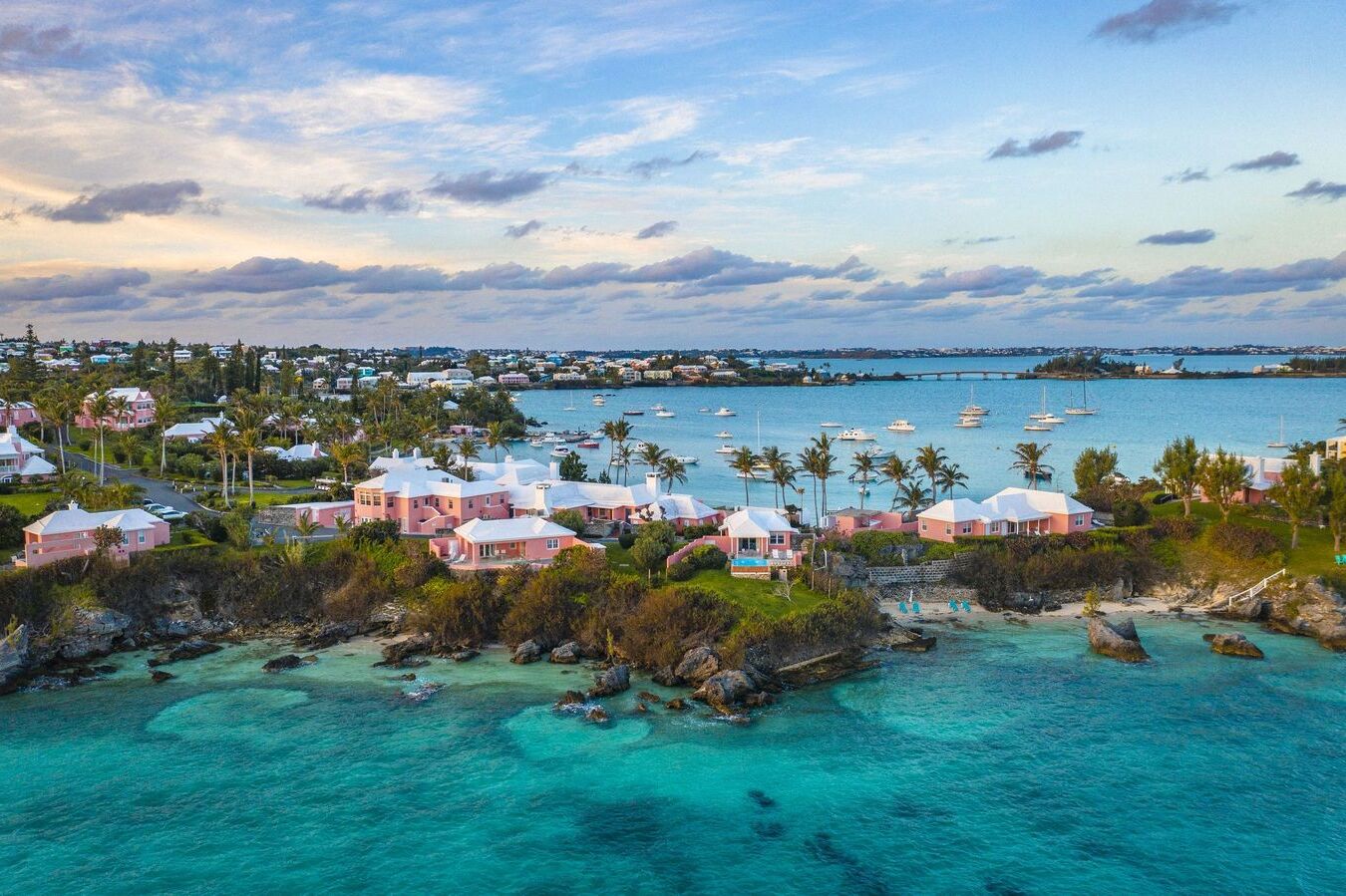
Why is Bermuda such a captivating destination? Bermuda, a British overseas territory in the North Atlantic Ocean, enchants visitors with its pink-sand beaches, crystal-clear waters, and rich history. This archipelago, comprising around 138 islands, offers a unique blend of British and American influences. From the historic town of St. George to the vibrant Gombey dance tradition, Bermuda's cultural heritage is diverse and colorful. The island's natural beauty extends beyond its shores, with flourishing coral reefs and mesmerizing crystal caves. Whether exploring underwater attractions or enjoying a traditional codfish breakfast, Bermuda promises a memorable experience for every traveler.
Key Takeaways:
- Bermuda's natural wonders, rich history, and vibrant culture make it a must-visit destination. From pink-sand beaches to historic sites, there's something for everyone to explore and enjoy.
- The mysteries of the Bermuda Triangle add an extra layer of intrigue to this fascinating destination. While scientific explanations offer plausible answers, the allure of the unknown continues to captivate visitors.
Location and Geography
Bermuda's unique location and geography make it a fascinating destination. Let's dive into some interesting facts about its place on the map and its physical features.
- Bermuda is situated in the North Atlantic Ocean, about 650 miles east-southeast of Cape Hatteras, North Carolina. This remote location adds to its allure.
- The archipelago consists of 181 islands, with a total area of 53.3 square kilometers (20.6 square miles). Despite its small size, it packs a lot of charm.
- The largest island is Main Island, also known simply as Bermuda. Eight larger and populated islands are connected by bridges, creating a seamless experience for travelers.
- Town Hill on Main Island is the territory's tallest peak, standing at 79 meters (259 feet) tall. It offers stunning views of the surrounding landscape.
- Bermuda's coastline stretches 103 kilometers (64 miles) long, providing ample opportunities for beachgoers and water enthusiasts.
Natural Wonders
Bermuda is renowned for its natural beauty, from its pink-sand beaches to its crystal-clear waters. Here are some facts that highlight its natural wonders.
- Bermuda's beaches are famous for their pink sand, which gets its hue from crushed coral, shells, and calcium carbonate. Horseshoe Bay Beach is the most iconic of these pink-sand beaches.
- The waters around Bermuda are crystal clear, offering virtually unlimited visibility for scuba divers and snorkelers. Church Bay is a popular spot for underwater exploration.
- Scuba divers can explore numerous wrecks and coral reefs in relatively shallow water, typically 30–40 feet (9–12 meters) deep. The underwater world of Bermuda is a paradise for marine enthusiasts.
- Bermuda's waters are teeming with vibrant coral reefs, supporting a diverse array of marine life, including colorful fish, sea turtles, and majestic eagle rays.
- The Bermuda longtail, or white-tailed tropicbird, is a beloved symbol of the island, known for its graceful flight and striking appearance. It is often regarded as a harbinger of good fortune.
Historical Significance
Bermuda boasts a rich history that dates back to the early 17th century. Its historical sites and traditions offer a glimpse into its storied past.
- Bermuda holds the distinction of being the oldest continuously inhabited English settlement in the New World, with a history that began in the early 1600s.
- St. George, a UNESCO World Heritage site, is a charming town that preserves Bermuda's colonial heritage. Its cobblestone streets and historic buildings transport visitors back in time.
- The Royal Naval Dockyard is one of Bermuda's most popular visitor attractions. It includes the National Museum of Bermuda and offers insights into the island's maritime history.
- Bermuda is home to several historic lighthouses, including the Gibbs Hill Lighthouse, which offers panoramic views of the island and its surrounding waters. It is one of the oldest cast-iron lighthouses in the world.
- The State House, dating back to 1620, is one of the oldest continuously occupied legislative buildings in the world. It stands as a testament to Bermuda's long-standing governance.
Cultural Heritage
Bermuda's culture is a vibrant blend of British, American, and African influences. This unique mix is reflected in its traditions, cuisine, and daily life.
- The Gombey dance and music tradition is an integral part of Bermuda's cultural heritage. It features vibrant costumes, rhythmic drumming, and energetic dance performances.
- A traditional Bermudian breakfast includes salted codfish, boiled potatoes, bananas, and avocado. This dish reflects the island's culinary traditions that blend African, Caribbean, and British influences.
- Bermuda shorts, a symbol of the island's casual elegance, were first introduced by the British military. Today, they are a quintessential part of Bermuda's culture.
- Moongates, circular stone arches said to bring good luck to those who pass through them, can be found in various locations across Bermuda. They are popular spots for romantic proposals and wedding ceremonies.
- The Bermuda Perfumery, established in 1928, is renowned for creating exquisite fragrances inspired by the island's natural beauty. Visitors can explore the perfumery's gardens and learn about the art of perfume-making.
Attractions and Activities
Bermuda offers a wide range of attractions and activities for visitors to enjoy. From museums to natural wonders, there's something for everyone.
- The Bermuda Aquarium, Museum and Zoo is a major attraction, featuring a variety of marine life and educational exhibits about the island's unique ecosystem.
- The Bermuda Underwater Exploration Institute is dedicated to the exploration and conservation of the ocean. It offers exhibits and educational programs for visitors.
- The Botanical Gardens in Bermuda are a serene oasis, featuring a variety of plant species and a tranquil atmosphere perfect for relaxation.
- The Masterworks Museum of Bermuda Art showcases a collection of Bermudian art, providing insight into the island's cultural heritage.
- Bermuda is home to mesmerizing crystal caves, such as the Crystal Cave and Fantasy Cave. These caves boast stunning formations of stalactites and stalagmites, as well as clear underground pools that create a magical ambiance.
Economy and Infrastructure
Bermuda's economy is driven by tourism, international business, and financial services. Its infrastructure supports a thriving community and a steady influx of visitors.
- Bermuda has a thriving economy, driven by tourism, international business, and financial services. The island is a major hub for offshore banking and insurance.
- Non-residents are prohibited from driving cars on the island. Public transport and taxis are available, or visitors can rent scooters for private transport.
- Bermuda has a well-developed education system, with several schools offering high-quality education to both locals and international students.
- The Bermuda Regiment, a reserve force, plays a vital role in the island's security and disaster relief efforts. It comprises infantry, engineers, and support units, and also assists in international peacekeeping missions.
- Bermuda's tourism industry is thriving, with many hotels located along the south shore of the island. The pink-sand beaches are a major draw for tourists.
Mysteries of the Bermuda Triangle
The Bermuda Triangle has long been shrouded in mystery, with numerous theories attempting to explain the strange occurrences in this region.
- The deepest point in the Atlantic Ocean, the Milwaukee Depth, is located in the Bermuda Triangle. The Puerto Rico Trench reaches a depth of 27,493 feet (8,380 meters) at the Milwaukee Depth.
- The Bermuda Triangle is one of the most heavily traveled shipping lanes in the world. Despite its reputation, the area does not have a high incidence of disappearances compared to other regions.
- Bermuda is also a significant hub for air traffic. The island's airport, L.F. Wade International Airport, handles a large volume of flights, both commercial and private.
- The Bermuda Triangle is subject to frequent tropical storms and hurricanes. The Gulf Stream, a strong ocean current, passes through the region, causing sharp changes in local weather.
- Some theories suggest that magnetic abnormalities in the Bermuda Triangle may cause issues with compasses, leading to confusion among pilots and captains about their direction.
Theories and Incidents
Various theories and historical incidents have contributed to the mystique of the Bermuda Triangle. Here are some notable examples.
- Many investigations into disappearances in the Bermuda Triangle indicate that human error or bad weather may be responsible rather than paranormal activity.
- Several historical incidents have contributed to the mystique of the Bermuda Triangle. The disappearance of Flight 19 in 1945 and the USS Cyclops in 1918 are two notable examples.
- Some theorists have linked the mysteries of the Bermuda Triangle to the lost city of Atlantis. However, there is no scientific evidence to support these claims.
- UFO theories suggest alien interference in the Bermuda Triangle. However, there is no credible evidence to support these claims, and most disappearances can be explained by natural causes.
- Pirate interference is another theory, but there is no historical evidence to support the idea that pirates are responsible for the disappearances in the Bermuda Triangle.
Scientific Explanations
While many theories exist, scientific explanations often provide the most plausible answers to the mysteries of the Bermuda Triangle.
- Some believe that large fields of methane hydrates in the Bermuda Triangle may be responsible for some of the mysterious disappearances. Methane hydrate can change water's density and lose its buoyancy, causing a ship to sink.
- The lack of modern weather radar systems in the past may have contributed to the high incidence of disappearances in the Bermuda Triangle. Weather seems an obvious answer to many of the incidents.
- Electrical malfunctions have been reported in the Bermuda Triangle. In 2017, a Turkish Airlines A330-200 experienced a series of electrical and mechanical malfunctions while routing over the Bermuda Triangle.
- When Christopher Columbus sailed through the Bermuda Triangle in 1492, he reported a fireball in the sky and strange compass readings. This incident has contributed to the mystique surrounding the region.
- Bermuda's unique blend of British and American influences, combined with its natural beauty and rich history, makes it a truly remarkable place to visit. From its pink-sand beaches to its vibrant culture, Bermuda offers a diverse array of experiences for travelers.
Unique Traditions and Customs
Bermuda's traditions and customs add to its unique charm. These practices reflect the island's rich cultural heritage and vibrant community.
- Bermuda was once a major producer of sweet onions, known as Bermuda onions. These onions were highly prized for their flavor and were often exported to other parts of the world.
- The traditional onion harvest is celebrated with festivals and events, showcasing the island's agricultural heritage.
- Bermuda's public transport system is well-developed, with buses and ferries providing convenient options for getting around the island.
- The island's education system includes several schools that offer high-quality education to both locals and international students.
- Bermuda's unique charm and captivating attractions make it a must-visit destination for any traveler.
Bermuda's Unique Allure
Bermuda stands out with its pink-sand beaches, crystal-clear waters, and rich history. This British overseas territory, with its blend of British, American, and African influences, offers a unique cultural experience. From the historic town of St. George to the vibrant Gombey dance tradition, there's always something captivating to explore. The island's natural beauty is complemented by attractions like the Crystal Caves and flourishing coral reefs. Bermuda's economy thrives on tourism, international business, and financial services. The Bermuda Triangle adds a touch of mystery, with theories ranging from magnetic abnormalities to methane hydrates. Whether you're diving into its underwater world or strolling through its historic streets, Bermuda promises an unforgettable adventure. Its unique charm and diverse attractions make it a must-visit destination for travelers seeking both relaxation and excitement.
Frequently Asked Questions
Was this page helpful?
Our commitment to delivering trustworthy and engaging content is at the heart of what we do. Each fact on our site is contributed by real users like you, bringing a wealth of diverse insights and information. To ensure the highest standards of accuracy and reliability, our dedicated editors meticulously review each submission. This process guarantees that the facts we share are not only fascinating but also credible. Trust in our commitment to quality and authenticity as you explore and learn with us.


